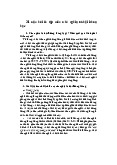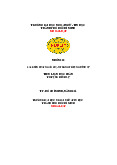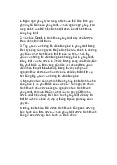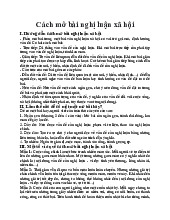



















Preview text:
QUẢN TRỊ HỌC
CHAPTER 1 - MANAGER AND MANAGEMENT
1. An organization is ________.
A. the physical location where people work
B. any collection of people who all perform similar tasks
C. a deliberate arrangement of people to accomplish some specific purpose
D. a group of individuals focused on profit-making for their shareholders
2. All organizations have ________ which define(s) the organization's purpose and reason for existing.
A. rules B. structure C. limits D. goals
3. Which of the following is a key difference between managerial and nonmanagerial employees?
A. Nonmanagerial employees do not oversee the work of others.
B. Managerial employees work longer hours.
C. Managerial employees receive higher pay compensation.
D. Nonmanagerial employees have less formal education.
4. The primary job of a manager is to ________.
A. coordinate between organization leaders and ordinary employees
B. direct and oversee the work of others
C. tackle tasks that are too difficult for nonmanagerial employees
D. make decisions that help an organization grow
5. One of the common characteristics of all organizations is ________ that define(s)
rules, regulations, and values of the organization.
A. a stated purpose B. a systematic structure
C. a set of written bylaws D. an explicit goal
6. The work of a manager ________.
A. is strictly limited to overseeing and monitoring the work of others
B. involves only high-level tasks that require a sophisticated skill set
C. may involve performing tasks that are not related to overseeing others
D. does not involve interaction with nonmanagerial employees
7. Supervisor is another name for which of the following?
A. team leader B. first-line manager
C. top manager D. middle manager
8. Which of the following types of managers is responsible for making organization-
wide decisions and establishing the plans and goals that affect the entire organization?
A. top manager B. team leader
C. department head D. project leader
9. Which is an important job responsibility for a middle manager?
A. defining the organization’s long-term goals
B. performing tasks that are not related to long-term goals
C. helping top managers define goals
D. translating goals defined by top managers into action
10. All levels of management between the supervisory level and the top level of the
organization are termed ________.
A. middle managers B. first-line managers
C. team leaders D. supervisors
11. Which of the following levels of management is associated with positions such as
executive vice president, chief operating officer, chief executive officer, and chairperson of the board?
A. middle managers B. top managers
C. first-line managers D. team leaders
12. Another term for efficiency is ________.
A. doing things right B. doing things at the right time
C. making sure things get done D. doing the right thing
3. Which of the following might be an example of increased efficiency in manufacturing?
A. cutting the price of the product
B. increasing advertising for the product.
C. cutting the amount of labor required to make the product
D. increasing sales of the product
14. Another term for effectiveness is ________.
A. doing things right B. doing things when necessary
C. doing the right things D. doing things intelligently
15. Effectiveness is synonymous with ________.
A. efficiency B. smart management
C. goal attainment D. cost minimization
16. Efficiency refers to ________.
A. the additive relationship between inputs and outputs
B. the inverse relationship between inputs and outputs
C. the relationship between inputs and outputs D. decreasing inputs only
17. Good management strives for ________.
A. high efficiency and low effectiveness
B. high efficiency and high effectiveness
C. moderate efficiency and moderate effectiveness
D. low efficiency and high effectiveness
18. A candy manufacturer would increase both efficiency and effectiveness by making ________.
A. the same candy at a lower cost B. better candy at a lower cost
C. the same candy at the same cost D. better candy at the same cost
19. A candy manufacturer that made candy at a lower cost without improving the
quality of the candy could be said to ________.
A. increase effectiveness without increasing efficiency
B. increase both effectiveness and efficiency
C. decrease both effectiveness and efficiency
D. increase efficiency without increasing effectiveness
20. Which of the following identifies a manager who does NOT typically supervise other managers?
A. shift manager B. unit chief C. division manager D. vice president
21. The four contemporary management processes are planning, organizing, leading, and commanding. A. True B. False
22. Determining who reports to whom is part of the controlling function of management. A. True B. False
23. Providing motivation is part of the controlling function of management. A.True B. False
24. Defining goals is a key part of the organizing function of management. A.True B. False
25. Deciding who will be assigned to which job is a part of the leading function of management. A. True B. False
26. In Mintzberg's view, the roles of figurehead, leader, and liaison are all interpersonal roles. A. True B. False
27. Disturbance handler is one of Mintzberg's interpersonal roles. A. True B. False
28. A typical first-level manager spends more of his or her time leading than planning A. True B. False
29. All managers devote at least some of their time to planning. A. True B. False
30. A manager in a large business generally will spend more of her time as a
spokesperson and entrepreneur than her counterpart in a small business A. True B. False
31. Today, the basic management functions are considered to be
A. planning, coordinating, leading, and monitoring
B. planning, organizing, leading, and motivating
C. commanding, organizing, leading, and decision making
D. planning, organizing, leading, and controlling
32. The controlling management function is largely a matter of A. resolving conflicts
B. determining what needs to be done
C. monitoring to see that tasks are accomplished
D. enforcing rules for employees 33. Organizing includes
A. defining organizational goals B. resolving conflicts
C. motivating organizational members D. determining who does what tasks
34. Resolving a conflict would be considered to fall under which managerial function?
A. controlling B. planning C. directing D. leading
35. Giving a speech at an organization banquet would fall into which Mintzberg category?
A. informational B. interpersonal C. decisional D. entrepreneurial
36. A pharmaceutical company manager attending a meeting of academic scientists
would be functioning in which role?
A. informational B. figurehead D. decisional C. liaison
37. All of the following are examples of informational roles according to Mintzberg EXCEPT
A. entrepreneur B. monitor C. disseminator D. spokesperson
38. Unlike the manager of a small business, the most important concerns of a manager
in a large organization are focused
A. externally, particularly on entrepreneurial tasks
B. internally, particularly on the allocation of resources C. on setting goals
D. on planning ways to improve organizational structure
39. Which of the following would networking be most likely to help a manager accomplish?
A. increasing efficiency B. increasing effectiveness
C. defining goals D. building a power base
40. Companies that are well managed can prosper during difficult economic times by depending on
A. government bailouts B. filing for bankruptcy
C. raising prices D. a loyal customer base
41. Which of the following is a factor in today's tough economic climate that
managers do NOT need to deal with? A. changing technology B. economic uncertainty
C. employees who are not eager to work
D. distrust between managers and employees
42. Brenda Kraft has proven herself to be an able manager. Her section has a high
project completion rate with the highest-quality product and the lowest defects in her
division. In addition, she accomplishes this with fewer full-time people than other
managers. Co- workers say that the secret of her success is in her ability to delegate
responsibility and her understanding of the basic "management processes."
Brenda's high project completion rate indicates that she is
A. an efficient manager B. an effective manager
C. a good spokesperson D. a good resource allocator
43. Brenda Kraft has proven herself to be an able manager. Her section has a high
project completion rate with the highest-quality product and the lowest defects in her
division. In addition, she accomplishes this with fewer full-time people than other
managers. Co- workers say that the secret of her success is in her ability to delegate
responsibility and her understanding of the basic "management processes."
If Brenda accomplished her projects on time with high-quality results, but she took
more time than other managers in the process, you could say that as a manager she was
A. efficient, but not effective B. a leader, but not a top manager
C. project oriented, but not effective D. effective, but not efficient
44. As a production supervisor, Joe determines the number of output units his
department will produce each week. On Monday, he informs his team that the
schedule is going to be difficult this week due to the increased number of output units.
He goes on to tell them that he is confident that they can fulfill the schedule because
they are tough, talented, and "when the going gets tough, they are the ones who get
going." Each day during the week, Joe checks the amount of output that the
employees have completed and the number of units that have been rejected.
When Joe decides the number of output units his team will be able to produce this
week, which of the management processes is he performing?
A. controlling B. leading C. planning D. organizing
45. In a short essay, discuss the difference between efficiency and effectiveness. -
Efficiency ("doing things right") - concerned with the efficient use those resources.
- Effectiveness ("foing the right things") - doing those work tasks that help the organization reach its goals
Chapter 2: The manager as decision maker
1. The second step in the decision-making process is identifying a problem. A. True B. False
2. A decision criterion defines factors that are relevant in a decision. A. True B. False
3. Managers identify a problem by comparing the current state of affairs to some standard. A. True B. False
4. All criteria are equally important in the decision-making process. A. True B. False
5. The final step of the decision-making process is to implement the alternative that has been selected. A. True B. False
6. One assumption of bounded rationality is that managers can analyze all relevant
information about all alternatives for a situation. A. True B. False
7. A synonym for the word satisfice is maximize. A. True B. False
8. Intuitive decision making is systematic, logical, and orderly. A. True B. False
9. Programmed decisions tend to be routine. A. True B. False
10. Group decisions tend to provide more complete information than individual decisions. A. True B. False
11. An advantage of group decisions is that they increase the perception of the legitimacy of the solution. A. True B. False
12. Groups tend to be more efficient and less effective than individual decision making. A. True B. False
13. A country with high uncertainty avoidance and high power distance is more likely
to engage in groupthink than a country with low uncertainty avoidance and low power distance. A. True B. False
14. Which of the following defines a problem in the decision-making process?
A. a discrepancy between what exists and what the decision maker desires to exist
B. a discrepancy between the ideal and the practical
C. something that causes irritation
D. something that calls for attention
15.The decision-making process consists of a series of eight steps that identify a
problem and work toward ultimately ________.
A. determining if there is a solution to the problem B. solving the problem
C. making a plan to solve the problem
D. breaking down the problem into a series of steps
16. A manager can faithfully execute the decision-making process, but still end up
with nothing of value if ________.
A. he fails to identify the correct problem
B. he fails to assign number values to different criteria
C. he solves the problem inefficiently
D. he fails to correctly identify the steps of the process
17. A manager is considering purchasing new computers for her department. The
manager spends time assessing the computers her department now has. Which stage of
the decision-making process is she going through?
A. identification of a problem B. identification of decision criteria
C. development of alternatives D. implementation of an alternative
18. A manager is determining what kind of new computers she should purchase for
her department. She has made a list of five different computer models for
consideration. Which stage of the decision-making process is this?
A. selection of an alternative B. identification of decision criteria
C. development of alternatives D. analysis of alternatives
19. After purchasing new computers for her department, a manager is now comparing
the performance of the new computers to the computers they replaced. Which stage of
the decision-making process is she carrying out?
A. analysis of alternatives B. evaluation of decision effectiveness
C. selection of an alternative D. implementation of an alternative
20. In allocating weights to the decision criteria, which of the following is most helpful to remember?
A. All weights must be the same.
B. The total of the weights must sum to 100.
C. The high score should be a 10, and no two criteria should be assigned the same weight.
D. Assign the most important criterion a score, and then assign weights against that standard.
21. The three main models that managers use to make decisions are ________.
A. rational, bounded rational, and intuitive
B. rational, irrational, bounded rational
C. intuitive, unintuitive, rational
D. bounded rational, intuitive, systematic
22. It is assumed that in most cases, the decisions of all managers are limited by ________.
A. greed and short-sightedness
B. having too much information
C. not being able to analyze all information for all alternatives
D. not being able to act rationally or in the best interests of their organization
23. Which term best characterizes a decision that has bounded rationality?
A. virtually perfect B. rigorous and comprehensive
C. not good enough D. good enough
24. Which of the following is the best definition for the word satisfice?
A. very satisfying B. not sufficient
C. accepts a less than perfect solution D. requires a perfect solution
25. A person who satisfices fails to ________.
A. maximize his or her decision B. understand his or her position
C. accept the truth of a situation D. make any kind of decision
26. Escalation of commitment can occur when people don't ________. A. want to make a decision
B. want to admit that an earlier decision was flawed C. accept current conditions
D. understand that conditions have changed
27. Which of the following is NOT a way in which intuition guides people who are making decisions?
A. Intuition provides ethics and values guidelines.
B. Intuition provides a formal analysis method.
C. Intuition provides experiences to draw from.
D. Intuition draws on knowledge, skills, and training.
28. Emotions and feelings ________ decision making.
A. have no effect on B. can improve
C. decrease performance in D. are more important than facts and logic in
29. Structured problems are ________.
A. ambiguous B. undefined and vague
C. clear and straightforward D. incomplete
30. Unstructured problems are ________. A. perfectly rational B. clear and straightforward
C. situations in which all options are known
D. situations in which all options are not known
31. Which of the following is an example of a structured problem? A. designing a new MP3 player



